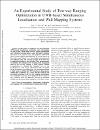An Experimental Study of Two-way Ranging Optimization in UWB-based Simultaneous Localization and Wall-Mapping Systems
Date
2022-01-01Metadata
Show full item recordAbstract
In this paper, we propose a new ultra-wideband (UWB)-based simultaneous localization and wall-mapping (SLAM) system, which adopts two-way ranging optimization on UWB anchor and tag nodes to track the target's real-time movement in an unknown area. The proposed UWB-based SLAM system captures time difference of arrival (TDoA) of the anchor nodes' signals over a line-of-sight propagation path and reflected paths. The real-time location of the UWB tag is estimated according to the real-time TDoA measurements. To minimize the estimation error resulting from background noise in the two-way ranging, a Least Squares Method is implemented to minimize the estimation error for the localization of a static target, while Kalman Filter is applied for the localization of a mobile target. An experimental testbed is built based on off-the-shelf UWB hardware. Experiments validate that a reflector, e.g., a wall, and the UWB tag can be located according to the two-way ranging measurement. The localization accuracy of the proposed SLAM system is also evaluated, where the difference between the estimated location and the ground truth trajectory is less than 1 meter.
Collections
- Computer Science & Engineering [2491 items ]


